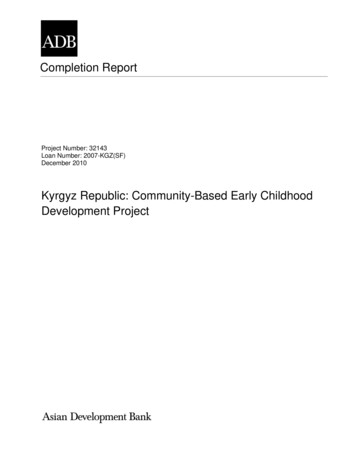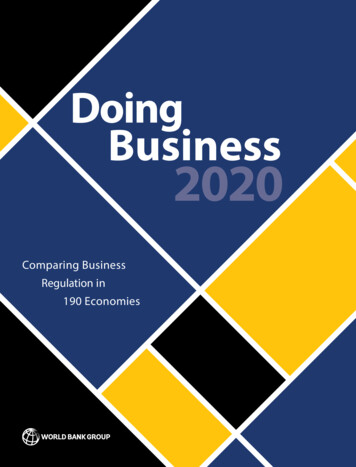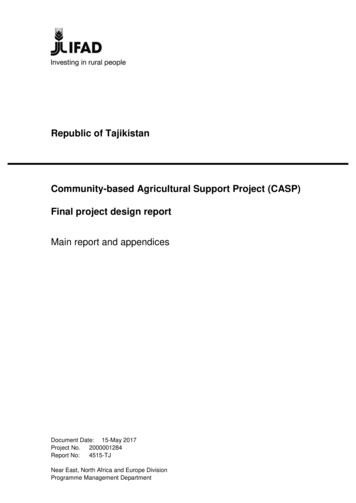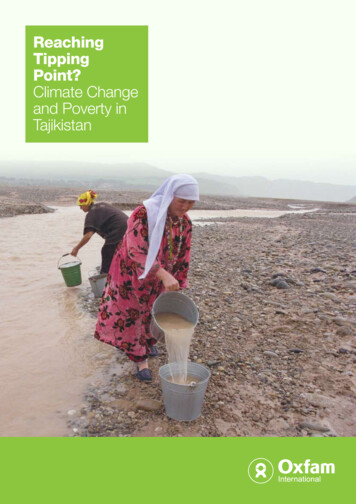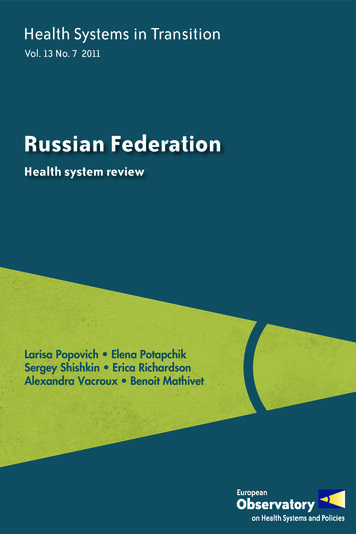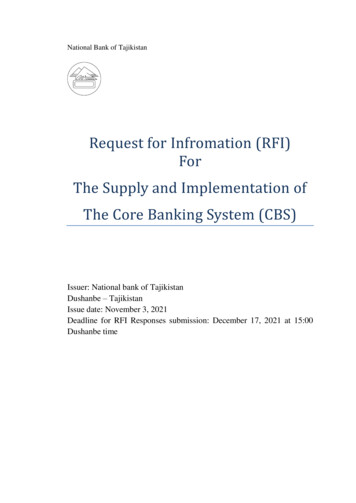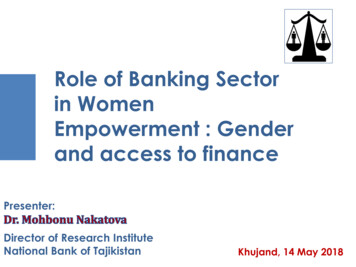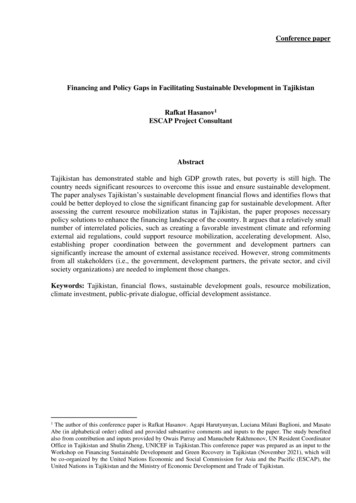
Transcription
Conference paperFinancing and Policy Gaps in Facilitating Sustainable Development in TajikistanRafkat Hasanov1ESCAP Project ConsultantAbstractTajikistan has demonstrated stable and high GDP growth rates, but poverty is still high. Thecountry needs significant resources to overcome this issue and ensure sustainable development.The paper analyses Tajikistan’s sustainable development financial flows and identifies flows thatcould be better deployed to close the significant financing gap for sustainable development. Afterassessing the current resource mobilization status in Tajikistan, the paper proposes necessarypolicy solutions to enhance the financing landscape of the country. It argues that a relatively smallnumber of interrelated policies, such as creating a favorable investment climate and reformingexternal aid regulations, could support resource mobilization, accelerating development. Also,establishing proper coordination between the government and development partners cansignificantly increase the amount of external assistance received. However, strong commitmentsfrom all stakeholders (i.e., the government, development partners, the private sector, and civilsociety organizations) are needed to implement those changes.Keywords: Tajikistan, financial flows, sustainable development goals, resource mobilization,climate investment, public-private dialogue, official development assistance.1The author of this conference paper is Rafkat Hasanov. Agapi Harutyunyan, Luciana Milani Baglioni, and MasatoAbe (in alphabetical order) edited and provided substantive comments and inputs to the paper. The study benefitedalso from contribution and inputs provided by Owais Parray and Manuchehr Rakhmonov, UN Resident CoordinatorOffice in Tajikistan and Shulin Zheng, UNICEF in Tajikistan.This conference paper was prepared as an input to theWorkshop on Financing Sustainable Development and Green Recovery in Tajikistan (November 2021), which willbe co-organized by the United Nations Economic and Social Commission for Asia and the Pacific (ESCAP), theUnited Nations in Tajikistan and the Ministry of Economic Development and Trade of Tajikistan.
CONFERENCE PAPER, TajikistanTable of contentsAcronyms and abbreviations .31. Introduction .52. Current status of financing for development in Tajikistan .62.1. Sustainable development trends .62.2. Sustainable development financial flows’ methodology and data .9Public domestic financial flows .10Private domestic financial flows .11External public financial flows .11External private financial flows .122.3. Funding the sustainable development and policy efforts to mobilize resources byTajikistan .12Investments .14a. Private investment .15b. Foreign direct investment .18c. Public investment .20Budget sector .22a. State budget revenues .22Remittances.26Official development assistance .293. Challenges and gaps faced by Tajikistan and selected policy cases to address them .323.1. Improving public-private dialogue for better investment climate .333.2. Improving external aid regulations .35Conclusions .38References .39Annex 1: Brief information of Tajikistan .43Annex 2: Demographic trends in Tajikistan .442
CONFERENCE PAPER, TajikistanAcronyms and PUNICEFAddis Ababa Action AgendaAsian Development BankAid Information Management SystemConsumer Price IndexCountry Preparedness and Response PlanDevelopment Assistance CommitteeEurasian Development BankEuropean Bank for Reconstruction and DevelopmentEuropean UnionForeign Direct InvestmentGross Domestic ProductGross National IncomeHuman Development IndexInternational Monetary FundIntegrated Socioeconomic Response FrameworkMinistry of Economic Development and TradeMinistry of Internal AffairsMigration Policy InstituteMinistry of FinanceMinistry of Health and Social protectionMedium-term Development ProgramNational Bank of TajikistanNational Development CouncilNational Development StrategyNon-Government OrganizationOfficial Development AssistanceOther Official FlowsRegional Bureau for Europe and the Commonwealth of Independent StatesPublic Investment ProgramPublic-Private DialogueStatistical Agency under the President of the Republic of TajikistanState Committee for Investments and State Property ManagementSustainable Development GoalsSystem of National AccountsTargeted Social AssistanceUnited NationsUnited Nations Department of Economic and Social AffairsUnited Nations Economic and Social Commission for Asia and the PacificUnited Nations Development ProgrammeUnited Nations Children’s Fund3
CONFERENCE PAPER, TajikistanUSAIDUSDUSSRUnited States Agency for International DevelopmentUnited States DollarUnion of Soviet Socialist Republics4
CONFERENCE PAPER, Tajikistan1. IntroductionAlthough Tajikistan has been demonstrating stable and high GDP growth rates for many years,overall and extreme poverty is still high, so the country needs significant resources to overcomethe issue and ensure sustainable development. The country is now at the demographic dividendperiod when a substantial proportion of the young population has reached the working age;however, the private sector has yet to create jobs adequately and increase its contribution to desiredsocioeconomic development. Against the backdrop of the unfolding COVID-19 pandemic, aslowdown of the GDP growth and people’s incomes has also become a particular challenge for thecountry.Tajikistan's investment climate must be significantly improved; the country's position in doingbusiness, despite some improvement in recent years, is still in the hundreds of the rankings (106in 2021), with the furthest ranking in North and Central Asia (World Bank, 2021a). Limitedexternal trade earnings with untapped investment potential and a rapidly growing youngpopulation suggest that the country should improve its business environment by mobilizingexternal and domestic resources.Tajikistan is a landlocked country, which means that its economic development faces severalchallenges inherent in such countries, as noted in a number of international conventions such asthe Almaty Programme of Action, the Vienna Programme of Action for Landlocked DevelopingCountries for the Decade 2014-2024 and the Political Declaration following the High-Level MidTerm Review of the Implementation of the Vienna Program of Action for Landlocked DevelopingCountries for the Decade 2014-2024. In particular, the following have been observed as crucialchallenges: Dependence on neighboring countries to access foreign markets via transit trade andlogistics; Cumbersome transit procedures for multiple border crossings; Inadequate and poor infrastructure and inefficient logistics systems; and High transportation costs.As a result, Tajikistan faces substantial structural constraints and is dependent on a very narrowrange of export commodities. Export earnings are substantially low compared to neighboringcountries like Kyrgyzstan and Uzbekistan.This paper aims to assess the current resource mobilization status in Tajikistan by identifyingfinancial and policy gaps in facilitating sustainable development. Based on the analyses, itproposes necessary policy solutions to enhance the financing landscape of Tajikistan.The paper is structured as follows: after this introduction, Section 2 describes Tajikistan’s presentfinancing landscape for development, paying particular attention to financing flows and theirchannels, values, and trends. Section 3 presents two policy interventions that require the country’simmediate attention for financial mobilization: improving public-private dialogue and external aidregulation. In conclusion, this paper summarizes key findings and recommendations derived fromthe analysis done in two sections.Finally, it is essential to underline that limited data availability in Tajikistan significantlyconstrained the analyses of this paper. Official statistics do not cover all financial flows, whileothers do not fully describe the detailed resources. Most of the data in the country are not publishedonline or published with significant delay. Despite some improvements made in recent years, the5
CONFERENCE PAPER, Tajikistanwebsite of the national statistical office (www.stat.tj) provides no up-to-date information on thesocioeconomic development of Tajikistan with some exemptions.22. Current status of financing for development in TajikistanTajikistan is a landlocked developing country of the south-eastern part of Central Asia.3 Due toits geographical location, Tajikistan faces several challenges posed by the remoteness and isolationfrom world markets, including higher transport costs, which have tremendous trade-reducingeffect and hinder sustainable development efforts. The national development strategy of theRepublic of Tajikistan for the period until 2030 (NDS 2030) responds to existing challenges bydeveloping appropriate strategic goals and key objectives. Nevertheless, the estimated fundingneeds for the next 15 years are still quite high (USD 118.1 billion) and resource mobilization needsto be further strengthened. This section describes Tajikistan’s present financing landscape fordevelopment, paying particular attention to financing flows in order to identify sources that can bebetter utilized.2.1. Sustainable development trendsTajikistan belongs to the medium human development countries group: it was ranked 125 with ahuman development index (HDI) score of 0.668 in 2019 (UNDP, 2020). The HDI of Tajikistansince 2000 shows some improvement; however, the annual growth rate of the HDI is slowing down– from 1.6% in 2000-2010 up to 0.6% in 2011-2019. Thanks to the maintenance of the previouslycreated infrastructure and new investments in health and education sectors supported by thedevelopment partners4, the country has high HDI components for these sectors: the live expectancyindex is 0.786, and the education index is 0.682 (World Bank, 2020a). All components of the HDIhave been growing, although the life expectancy index and education index are at a slow pace. Thelive expectancy index grew on average in 2011-2019 by 0.5%, and the education index by only0.3%. At the same time, the income index is lower and is only 0.555. Although it is growing at anoticeable rate of 1.1% annually, it is the component that is responsible for the low place in HDIrankings, as according to the gross national income (GNI) per capita ranking, Tajikistan is 25places below than it is in HDI.Over the years of independence, Tajikistan has achieved some improvement in addressing theproblems of gender inequality; however, according to the gender inequality index, Tajikistanranked 84th out of 162 countries in 2018. Although the index has fluctuated in recent ten years, animprovement during 2016-2018 can be noted.Tajikistan is a developing agro-industrial country with a GDP of about USD 8.0 billion in 2020 orUSD 846.7 per capita, with a high poverty rate. Among the former Soviet Union countries,Tajikistan consistently ranks last in terms of GDP per capita in purchasing power parity (3,519.8current USD in 2019).For more than 20 years, the economy of Tajikistan has been demonstrating a high growth rate. Theaverage annual economic growth rate in 2011-2019 was 7.1%. This is especially remarkable as by1995, Tajikistan lost more than half of the GDP compared to 1990 due to the collapse of the USSR2Most of time series data are available up to 2019. Data after 2020 were obtained from offline publications of thenational statistical office and online publications of the national bank and also were calculated based on the author'sown estimates. The author thanks Lyudmila Borunova for collecting all data from offline sources.3For more information on Tajikistan, please check Annexes 1 and 2.4According to the World Bank report, Tajikistan's Human Capital Index is higher than the average for countries withcomparable income levels. The Human Capital Index includes indicators of health and education (World Bank,2020a).6
CONFERENCE PAPER, Tajikistanand the following civil war. Various sources indicate that economic growth was achieved due toseveral sequential factors that happened in different periods. An initial low GDP level base(resulting from the economic collapse during the years of transformation and civil war) led tohigher rates in the next period, including a significant inflow of remittances, a high level of publicinvestment and a foreign investment growth (Rahimzoda and Hasanov, 2019). However, economicgrowth lacks several sustainable features. Macroeconomic stabilization has not yet been achieved;the year-to-year consumer price index (CPI) began to increase - in 2019, it was 7.8%, and in 2020,it grew to 8.6% (Statista, 2020) - and the national currency was devalued by more than 30% since2016. This led to a somewhat paradoxical result and, despite the high rates of economic growth,the World Bank downgraded Tajikistan from a lower-middle-income economy to a low-incomeeconomy in the Fiscal Year 2019 using gross national income per capita, calculated on the WorldBank Atlas method (World Bank, 2018b).Despite the economic growth, the high levels of poverty, insufficient educational potential of theyoung population, and unemployment brought significant risks for economic growth andsustainable development in the country. For several years, Tajikistan has remained a country withlow living standards of the population and, although the level of poverty gradually has decreasedbefore the COVID-19 pandemic – the overall poverty fell from 31.0% in 20155 to 26.3% in 2019and the level of extreme poverty dropped from 15.7 to 10.7% during the same period 6 - it is stillrelatively high.Families with many children (a study by the Statistical Agency under the President of the Republicof Tajikistan (SAPRT), World Bank and United Nations Children’s Fund (UNICEF) found thatpoverty rates are higher among children than adults) and women (the gender wage gap is 59.6%)are most at risk of poverty (SAPRT, World Bank and UNICEF, 2019). The year 2020 createdproblems for many households, and according to the Listening to Tajikistan survey, the share ofthe population who consider themselves poor subjectively increased to 49.5% in April 2020 (vs.32.1% in April 2019) and remained at more than 45% until the end of the year. While the economicimpacts of the crisis gradually moderated, many households had still not fully recovered by theend of the year. Hiring, employment, and food security all remained below pre-pandemic levels.Nevertheless, the outlook has now been improving: about 75% of respondents said they were veryconcerned about the pandemic’s health or economic impacts in May 2020, compared to below36% in January 2021 (World Bank, 2021c).Moreover, environmental problems and vulnerability are highly significant in Tajikistan,especially in the context of climate change, as evidenced by the trends highlighted in the UnitedNations Development Programme (UNDP) global human development report for Tajikistan(UNDP, 2020). Since 2000, carbon dioxide emissions have been steadily growing in Tajikistanand natural resource depletion has increased; renewable energy consumption (% of total finalenergy consumption) is decreasing. In terms of mortality rates from air pollution and unsafe watersupply, sanitation and hygiene (per 100,000 population), Tajikistan consistently ranks the worst inthe North and Central Asian region.Thus, despite some improvements in certain components of sustainable development, Tajikistanas a developing country is exposed to both external and internal challenges that can affect the SDGachievement. Moreover, being a landlocked country, Tajikistan faces the challenges posed by theremoteness and isolation from the world markets, additional border crossings, cumbersome transitprocedures, and inefficient logistics systems. Consequently, higher transport and other trade5Tajikistan began using new poverty measurement methodology since 2015 (SAPRT, 2020a).Poverty data are published in the quarterly Food Security and Poverty Publication on the SAPRT website, the latestpublication is available for Q2 2020 (SAPRT, 2020b).67
CONFERENCE PAPER, Tajikistantransaction costs compared to coastal countries present a tremendous trade-reducing effect that hasa direct negative impact on economic growth and puts Tajikistan at a disadvantage in fullyharnessing its potential to support its sustainable development efforts.The communication deadlock, the existence of which is recognized in key strategic policydocuments of the Republic of Tajikistan, also leads to the negative number of factors hinderingthe socio-economic development of the country: spatial and transport restrictions on the processes of diversification in the country; isolation of the Tajik energy system from the Central Asian energy system and othercountries, which significantly limits the possibilities for realizing the export hydropowerpotential and reduces the power supply reliability in certain seasons (damage, caused byimposing restrictions on the supply of electricity in winter is USD 200 million per year,according to the World Bank estimates) (World Bank, 2012); high cost of information and communication services in the country compared to otherCentral Asian countries – Tajikistan's neighbors.The NDS 2030 responds to the existing challenges by developing appropriate strategic goals andkey objectives. The ultimate goal of the long-term development of Tajikistan is to improve thestandards of living of the population based on sustainable economic development (Ministry ofEconomic Development and Trade of the Republic of Tajikistan, 2016). In order to achieve it, thefollowing strategic development objectives are defined for the period until 2030:a)b)c)d)Ensure energy security and efficient use of electricity;Exit from communication deadlock and turn country into a transit country;Ensure food security and people's access to good quality nutrition; andExpand productive employment.The latter was reformulated on 26 Dec 2018, when the president of Tajikistan, in his address tothe parliament, proposed to declare the fourth strategic objective to accelerate the country’sindustrialization, taking into account the importance of the industrial sector in solving social andeconomic issues and creating jobs. However, the relevant changes have not yet been included inthe NDS 2030; the Medium-term Development Program (MTDP) until 2025, which possiblyincludes this latest amendment, has not yet been published.NDS 2030 also stipulates that the country seeks to solve the following three key tasks at the newstage of development: (i) achievement of the level of socio-economic development, comparablewith the countries of the middle segment with middle level of income; (ii) ensuring sustainabledevelopment through diversification and boosting the competitiveness of the national economy,(iii) expanding and strengthening the middle class.The NDS 2030 mentioned that the estimated funding for the next 15 years for all sources offinancing of the strategy is USD 118.1 billion, of which the private sector accounts for USD 54.7billion (46.3%), budgetary funds for USD 56,1 billion (47.5%) and the development partners’funds for USD 7.3 billion (6.2%) (Ministry of Economic Development and Trade of the Republicof Tajikistan, 2016).The national report on the implementation of strategic documents of the country in the context ofthe sustainable development goals (SDG) noted significant progress in achieving severalobjectives in Tajikistan. At the same time, it says that state budget funding of the SDG-relatedinterventions will not be sufficient due to the limited budget. A more important role in financingthe NDS-2030, MTDP-2020 and SDGs commitments should belong to the private investments8
CONFERENCE PAPER, Tajikistan(both direct foreign and internal). The report referring to the UN financial analysis of theimplementation of the SDG in Tajikistan demonstrated that the Government of Tajikistan islagging in attracting the financial resources needed for implementation of the NDS 2030 and SDGsby 6.7% (Ministry of Economic Development and Trade of the Republic of Tajikistan, 2018).Covid recovery response: Tajikistan’s economy has been experiencing a fast recovery from theCOVID-19 pandemic. According to official estimates, real GDP grew by 8.7% year over year inthe first half of 2021 after growth slowed to 4.5% in 2020 (World Bank, 2021b). The governmentof Tajikistan undertook specific actions to mitigate the diverse circumstances of the pandemic andassisted vulnerable people through the integrated socioeconomic response framework (ISEF).ISEF Tajikistan is anchored to the prime minister’s action plan to combat the spread of COVID19 and is linked to the Tajikistan COVID-19 country preparedness and response plan (CPRP) andthe ministry of economic development and trade (MEDT’s) economic plan (UN Tajikistan, 2020).2.2. Sustainable development financial flows’ methodology and dataFinancing for sustainable development should be linked with the three key dimensions ofsustainable development: the economic, social and environmental. Addis Ababa Action Agenda(AAAA), a new global framework for financing sustainable development, aligns all financingflows and policies with economic, social and environmental priorities and ensures that financingis stable and sustainable. This agenda addresses all sources of finance: public and private, domesticand international.The above-mentioned national report proposes the following classification of financial flows:Table 1: Classification of financial flowsDomesticExternalPublic Tax revenues Non-tax revenues Government borrowing atdomestic market Official DevelopmentGrants (ODA) and loans Other Official Flows (OOF) PrivateProfit/income of domestic enterprisesDomestic equityDomestic creditNational NGOs International financial marketsInternational NGOsForeign Direct Investment (FDI)RemittancesSource: Author’s compilation based on Ministry of Economic Development and Trade of the Republic of Tajikistan(2018).The author has added an important financial flow, namely "Profit/income of enterprises" into thisclassification7. This flow is very important, since investments are often financed from the incomeof enterprises received by sales in both domestic markets and export markets.Before analyzing trends in these indicators, some methodological details related to these flowsshould be considered, which include the following:1. To what extent are these flows related to development?2. Are data and metadata available in Tajikistan statistics describing these flows?7Initially this classification was proposed by Claussen and Sultonov (2018) in Financial analysis to support SDGimplementation in Tajikistan.9
CONFERENCE PAPER, TajikistanMany studies analyze these financial flows in terms of their impact on development. It is not thepurpose of this study but to give statements that emphasize certain theoretical aspects relevant tothe context of Tajikistan and illustrated by a quantitative analysis of these flows further in thispaper.It is theoretically and empirically proven that the budget positively impacts development if itreallocates funds in favor of human capital development, improves health and education, andreduces poverty. In this regard, AAAA emphasizes that mobilizing domestic public resources iscentral to achieving the agenda 2030 and welcomes efforts by countries to set nationally defineddomestic targets and timelines for enhancing domestic revenue.However, the growth in budget expenditures does not work only in favor of development. Theincrease in expenditures due to an increase in taxes can lead to an excessive tax burden, reducingthe resources of the private sector directed to development. If budget spending grows due to anincrease in the budget deficit or public debt, this can lead to negative macroeconomicconsequences in the form of a public debt overhang or inflation. It should be especially emphasizedthat an increase in non-tax revenues might negatively affect economic growth if the growth in nontax revenues is supported by an increase in fees for licenses and permits, therefore increasing thedoing business costs. In this case, one can assume that an increase in social sectors’ spending is animportant trend from the point of view of supporting human development, but the efficiency andeffectiveness of these costs could be assessed after the complete macroeconomic analysis done.Another important example is remittances. Traditionally, they were assigned the role of amacroeconomic indicator that balanced the current account of the balance of payments; that is,they ultimately funded imports only, as they would go back abroad and, therefore, would notparticipate in the development in any way. Only recently, this indicator began to be consideredfrom the point of view of human and physical capital development.From the point of view of private business, foreign direct investment (FDI) and domesticinvestments are aimed at development, but if it generates negative externalities, for example,leading to an increase in environmental pollution, public losses may outweigh private benefits.Also, borrowing for development purposes from the banking sector could create preconditions thatdeteriorate development. in case of underdeveloped markets, which can be the result of the actionsof government agencies, when government supervision is not functioning to ensure their safetyand soundness.Official development assistance (ODA) also requires careful analysis. ODA contributes todevelopment only if it meets the country's priorities.Public domestic financial flowsAssessment of the availability of information shows significant restrictions on most of the data.Revenue and expenditure data for 2016-2020 are presented in aggregated form on the website ofthe Ministry of Finance (MoF). However, these data are not available in full accordance with thecountry’s budget revenue and expenditure classifications, limiting the possibilities for budgetanalysis. It is important that the program budget is presented in a very limited format in the Statebudget law. For example, article 7 of the budget law 2019 stipulates "to approve the expendituresof the republican budget for 2019 by program classification according to Appendix 2 in the sectorsof education, health care, social insurance and social protection, fuel and energy complex,agriculture, fishing, transport and communication" (Tax Committee of the Republic of Tajikistan,2019, pp. 5). However, the planned and executed financial and non-financial data in particular ofthe budget programs are not presented on the website.10
CONFERENCE PAPER, TajikistanIt should be emphasized that the value and composition of the budget deficit data presented in therelevant article of the Budget Law do not adequately reflect the internationally establishedprinciple of calculation, which limits analysis of the government borrowing. External debt data arereleased with a delay.Private domestic financial flowsData on domestic credit are presented on the National Bank of Tajikistan (NBT) website in theBulletin of the National Bank. There is no data on the private sector securities market due to itsunderdevelopment. However, it seems that in Tajikistan, the financial flows of the private sectorshould be assessed not by the securities market and the amount of domestic credit but by theindicators of private domestic investment in fixed assets.Fixed capital invest
NBT National Bank of Tajikistan NDC National Development Council NDS National Development Strategy NGO Non-Government Organization . national statistical office and online publications of the national bank and also were calculated based on the author's own estimates. The author thanks Lyudmila Borunova for collecting all data from offline .
